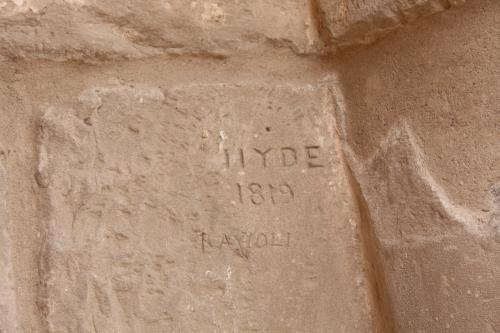Giovanni Finati’s account of his own travels in Egypt and the Levant as dragoman for several British visitors includes several references to Hyde. In 1819 Hyde was in Egypt and cut his name and date on a temple at Karnak and a stele at Aswan – ‘HYDE 1819’. Someone he knew at that time was William Bankes and there is a letter from Hyde to Bankes in the latters archives at Kingston Lacey in Dorset. He was writing from Cairo in October 1819 about his recent visit to St Catherine’s Convent in Sinai and his failure to find a text Bankes had seen. In June-July 1820 he appears in the pages of Henniker’s account of his travels in Palestine and we learn there that when Henniker was robbed, one of the items he never recovered was a book of Hyde’s that “contained his journal to the Oasis” – presumably Siwa. The British Library has many of Hyde’s papers including journals relating to some of his travels in the Levant in 1820 and 1821 – Lebanon, Syria (including Palmyra) and Persia. By 10 June 1822 he was at Poona in India (where he died of cholera at Moorshedabad in Bengal on 24 April 1825).

Hyde’s name and date carefully incised in the surface of the temple at Karnak (Photo: Alan Fildes)
None of the surviving documents just cited include a visit ‘east of Jordan’ but he can in fact be placed at three locations there. In 1863 the French expedition of Félicien de Saulcy recorded that when they reached the Nabataean temple at Al-Qasr in Moab, they discovered “ we are not the first who visit it, for we read on the vestibule wall the name HYDE, followed by 1822.” A few months later while in Amman and examining the Umayyad palace on the citadel who did they meet again but ‘HEYDE (sic)’. In 1882 Captain Conder guided two British royal princes through the region including a visit to Salt where he recorded near a spring just south of the town “A small tablet, painted in red with the name of an early explorer, was observed on the side wall of this monument (= tomb/ chapel).” It read ‘HYDE 1820’.

A painted grafitto on a Roman tomb/ church at Salt. Drawing: C. Conder 1882: 217
There is a conflict with the dates and – unless we posit two trips east of Jordan, the year 1820 fits best with what else we know of his itinerary. Whichever year it was, Hyde is one of the very earliest western travellers in what is now Jordan and surely stimulated by his time spent in Egypt with Bankes and Finati who had been in northern Jordan in 1816 and 1818. Was he – like the handful of earlier western visitors to Al-Qasr, going to or coming from Petra?